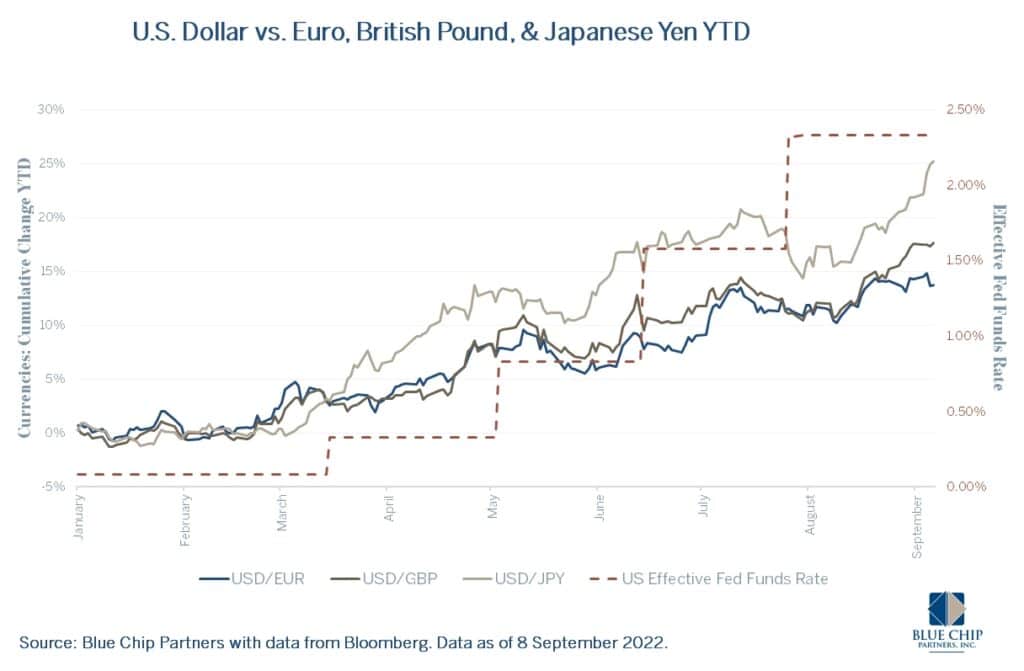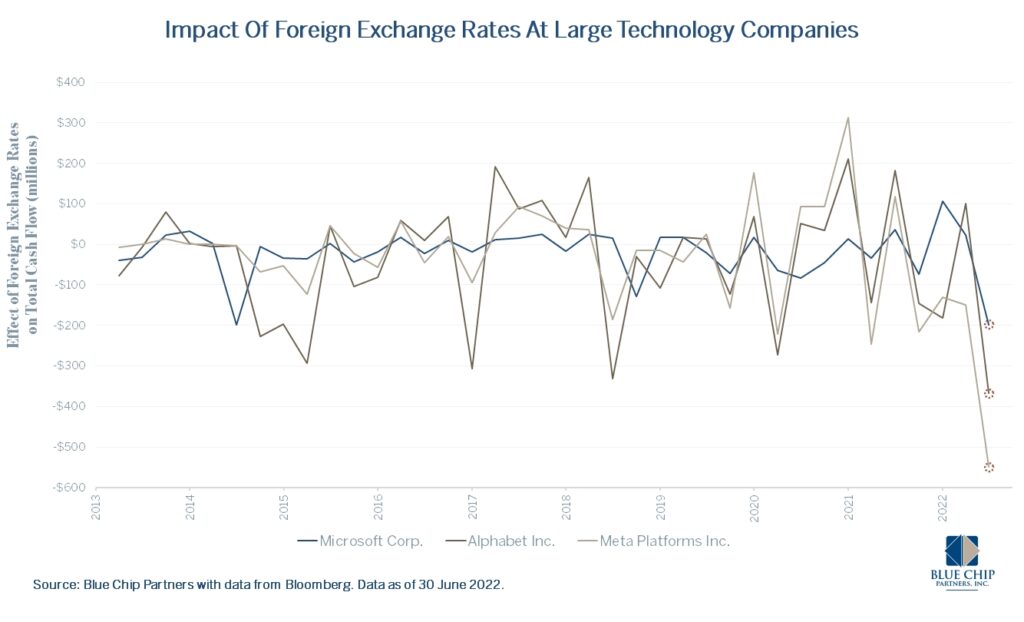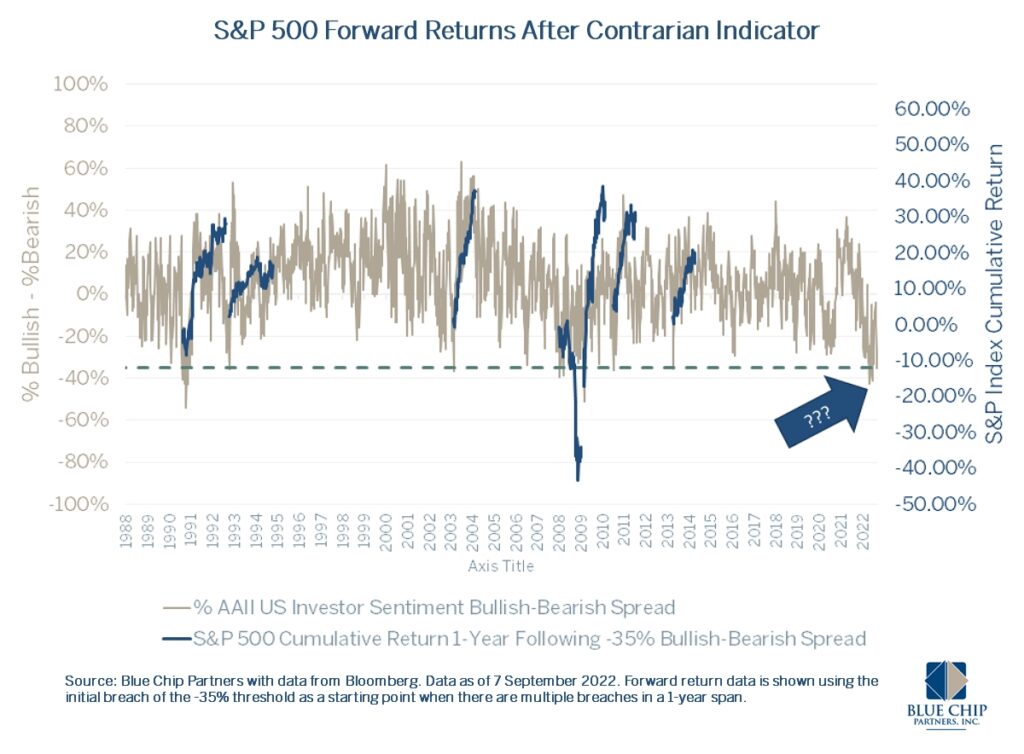Market Outlook
As the season changes, market participants are feeling a slight chill in the financial market backdrop and the temperature outside. Sentiment and consumer spending are cooling, as is the resultant level of overall economic growth. However, not all aspects of today’s markets align with the conditions that describe cider and donuts season. The Federal Reserve and the U.S. Dollar both continue to run hot, as does the pricing pressure felt by domestic consumers.
Strength in the U.S. Dollar (USD) has proved a dominant trend through 2022, and to understand what has driven this relative strength requires an understanding of monetary policy and underlying economic conditions.
Monetary Policy And The Dollar
Monetary policy has a direct effect on the value of global currencies. To accomplish their stated objectives, central banks can use two primary tools: purchasing or selling assets on the open market (usually government bonds) and increasing/decreasing the country’s baseline interest rate. When a central bank is looking to spur growth, as the Federal Reserve targeted from 2008-2014 and 2020-2021, a supportive monetary policy will be enacted. This includes the purchase of securities on the open market, which increases the money supply and lowers the yield of financial assets. Simultaneously, the central bank will reduce its benchmark interest rate in an effort to stimulate borrowing. Taken together, the now lower yields offered by the country result in capital outflows as investors will look elsewhere for more attractive levels of income. This reduced foreign demand for the country’s money leads to a weaker currency. Today, the exact opposite is taking place – there is too much money chasing too few items (inflation), and a more restrictive stance is necessary. The Federal Reserve is selling securities (reducing the money supply) and is rapidly increasing interest rates. Given the higher yields offered, foreign investors are attracted to USD-denominated securities, which results in more demand for the Dollar and ultimately more purchasing power for the currency relative to others around the globe.

1. Making Cents Of The Dollar
Economic Conditions And The Dollar
Further, investors look at more than just the attractiveness of yields in their considerations of where to deploy capital – the underlying economic health of a country is paramount. Although the U.S. economy is currently dealing with inflationary dynamics, the run in the USD is reflective of the perceived strength in the U.S. economy relative to Europe, China, and other emerging markets, along with the rest of the world. In the U.S., unemployment is low, manufacturing and industrial production are still expanding, and debt relative to disposable personal income is below historical averages. Compared to elements such as the expected 80% increase in household energy bills in the United Kingdom, the vote of confidence implied by foreign investors through a rising Dollar is understandable.
What Does It Mean Going Forward?
Going forward, the impact of a higher USD on multinational corporations should be watched closely. While a strong Dollar is advantageous for U.S. consumers that are looking to buy imported goods or travel to other countries, a stronger currency can have negative effects on corporate earnings. For example, €1.00 (1 Euro) in September 2021 was equivalent to $1.17 U.S. Dollars. Today, €1.00 can be exchanged for -$1.00 – the two currencies are at parity for the first time since 2002. Put differently, an international firm that is looking to purchase a $1,000,000 piece of equipment from a domestic firm will experience a N 15% markup today relative to what would have been paid one year ago. Domestic firms that have significant non-U.S. exposure are at risk, as American products are now more expensive in places such as Europe and Japan. This can impact quarterly revenue and profitability figures. Although the outcomes exhibited broadly by U.S. firms during the second quarter reporting season were better than feared, selectivity remains key in this market.

Economic Conditions And The Dollar
Further, investors look at more than just the attractiveness of yields in their considerations of where to deploy capital – the underlying economic health of a country is paramount. Although the U.S. economy is currently dealing with inflationary dynamics, the run in the USD is reflective of the perceived strength in the U.S. economy relative to Europe, China, and other emerging markets, along with the rest of the world. In the U.S., unemployment is low, manufacturing and industrial production are still expanding, and debt relative to disposable personal income is below historical averages. Compared to elements such as the expected 80% increase in household energy bills in the United Kingdom, the vote of confidence implied by foreign investors through a rising Dollar is understandable.
What Does It Mean Going Forward?
Going forward, the impact of a higher USD on multinational corporations should be watched closely. While a strong Dollar is advantageous for U.S. consumers that are looking to buy imported goods or travel to other countries, a stronger currency can have negative effects on corporate earnings. For example, €1.00 (1 Euro) in September 2021 was equivalent to $1.17 U.S. Dollars. Today, €1.00 can be exchanged for -$1.00 – the two currencies are at parity for the first time since 2002. Put differently, an international firm that is looking to purchase a $1,000,000 piece of equipment from a domestic firm will experience a N 15% markup today relative to what would have been paid one year ago. Domestic firms that have significant non-U.S. exposure are at risk, as American products are now more expensive in places such as Europe and Japan. This can impact quarterly revenue and profitability figures. Although the outcomes exhibited broadly by U.S. firms during the second quarter reporting season were better than feared, selectivity remains key in this market.
2. Zig When The Market Zags
Periods of turbulent equity market returns can produce a strong emotional response from investors. Some may change asset allocation levels, others load up on defensive exposure, and others may exit entirely and hoard cash. However, extrapolating the poor returns previously experienced in a volatile environment is not only indicative of recency bias but also akin to driving on the highway with the rearview mirror as a guide. By the time the average investor turns bearish, the pain has already been felt by market participants. Look to the AAII Sentiment Survey as an example. This survey offers insight into the opinions of individual investors by asking them about their current expectations for future market returns (bullish, neutral, or bearish). Based on its 30+ year history, the survey is a contrarian indicator: above-average market returns have often followed unusually low levels of optimism, while below-average market returns have often followed unusually high levels of optimism. When bears outnumber bulls by more than 35%, market returns over the next 12 months have been positive in 12 of 13 instances since 1988, with the average return exhibited by the S&P 500 Index nearly +20%. Further, when less than 20% of individuals are bullish, the U.S. market returns were positive in 19 of 20 instances with an average return of 17.5%. In April, bears outnumbered bulls by the widest margin since the depths of the financial crisis. The bullish sentiment returned through June and July on the back of a strong performance, but the bearish sentiment is now back to extreme levels. What does history tell us about the potential path forward?

So, what does this mean for us today? Well, in April of 2022, we hit a level of bearishness relative to bullishness that hasn’t been seen since 2009. After a brief period of reversion through June and July, which, mind you, coincided with very strong equity market returns. We now find ourselves at a key threshold, which is where bearish observations outpaced bullish observations by 35 points. So, based on history, this is a compelling observation for us.
3. Blue Chip Radar
Keeping with the theme of the Blue Chip Radar that we have put forth over the two quarters, for the coming quarter, we feel it beneficial to home in on specific catalysts that could spur optimism or reiterate pessimism through the end of the year.
Download the full Q4 2022 Report below to get more insight from Blue Chip Partners.
Blue Chip Partners Quarterly Edge Report – October 2022
Looking for more market insight?
Join us live on October 13th and listen to our Director of Investments, Daniel Dusina, dive deeper into the latest Quarterly Edge report where he will discuss three key things we are watching this quarter. This is your opportunity to ask Daniel your questions. Register now.
Thursday, October 13th
4 P.M. ET – 4:30 P.M. ET
Click below to save your spot!
Expressions of opinion are as of 30 September 2022 and are subject to change without notice. Any information provided is not a complete summary or statement of all available data necessary for making an investment decision and does not constitute a recommendation to buy, hold, or sell any security. There are limitations associated with the use of any method of securities analysis. The information has been obtained from sources considered to be reliable, but we do not guarantee that the foregoing material is accurate or complete. Every investor’s situation is unique, and you should consider your investment goals, risk tolerance, and time horizon before making any investment. Prior to making an investment decision, please consult with your financial advisor about your individual situation. Past performance does not guarantee future results. Investing involves risk, and you may incur a profit or loss regardless of strategy selected. There is no guarantee that any statements, opinions, or forecasts provided herein will prove to be correct. Dividends are not guaranteed and must be approved by the company Board of Directors. Indices are included for informational purposes only; investors cannot invest directly in any index.
1Source: Blue Chip Partners with data from Bloomberg. Data as of 8 September 2022.
2Source: Blue Chip Partners with data from Bloomberg. Data as of 30 June 2022.
3Source: Blue Chip Partners with data from Bloomberg. Data as of 7 September 2022. Forward return data is shown using the initial breach of the -35% threshold as a starting point when there are multiple breaches in a 1-year span.